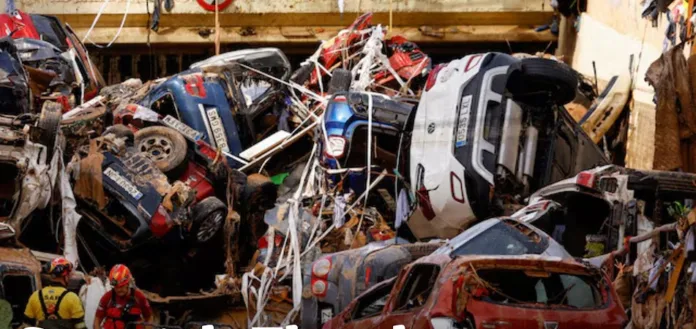A teacher’s harrowing experience in Valencia amidst Europe’s worst natural disaster in fifty years
An Australian teacher, Caroline Doyle, has shared a haunting account of her experience in central Valencia, Spain, following catastrophic flooding that has claimed at least 205 lives. Describing the scene as akin to a “war zone” or “apocalypse,” Doyle’s reflections highlight the surreal and devastating impact of what has been termed Europe’s worst natural disaster in five decades.
The calamity struck on Tuesday, a day when Doyle left her home under ominous weather warnings, taking only a jacket for protection. Little did she know that within 24 hours, she would return to her town of Paiporta engulfed in mud and chaos. “It felt like we were in a movie with special effects… it just seemed unbelievable,” she remarked, capturing the eerie atmosphere that enveloped the area.
Witnessing the aftermath, Doyle described the streets littered with cars and debris, floating in the murky floodwaters that had surged like an unstoppable tidal wave. The floodwaters, reminiscent of a tsunami in their ferocity, left a trail of destruction that turned the once-familiar landscape into a nightmarish scene. Rescue workers combed through the wreckage, going from car to car in search of survivors, a testament to the urgency and despair that permeated the air.
In the wake of the disaster, Spanish authorities have mobilised additional resources, deploying around 500 soldiers to aid in the search and rescue efforts. Unfortunately, the death toll is expected to rise, prompting the establishment of a temporary morgue in a convention centre on the outskirts of Valencia.
As the clean-up efforts unfold, with around 75,000 people still without power and many areas isolated from assistance, communities like Paiporta grapple with the overwhelming task of restoring normalcy. Residents, like Doyle, are left to sift through the ruins of their homes, which have become akin to abandoned film sets, echoing the chaos of the disaster.
Reflecting on her experience during the height of the flooding, Doyle recounted a moment of sheer terror. As water surged into the streets near her school, she and two of her students were forced to seek refuge in the apartment of a local woman. What began as a normal rainy evening quickly escalated into a dramatic rescue scenario. “We heard the boom of the doors of the house being ripped off in front of us and the water just flooding in,” she recalled, encapsulating the panic and urgency of the moment.
The aftermath of these floods serves as a stark reminder of nature’s formidable power, leaving communities to rebuild from the ashes of devastation. As the waters recede, the resilience of the human spirit will undoubtedly shine through, but the scars of this disaster will linger, marking a poignant chapter in Spain’s history.
